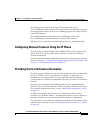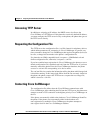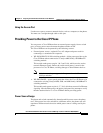
2-3
Cisco IP Phone Administration Guide for Cisco CallManager 3.2, Cisco IP Phones 7960/7940/7910
78-10453-04
Chapter 2 Preparing to Install the Cisco IP Phone on Your Network
Understanding the Phone Startup Process
This shared physical link has the following implications for the VLAN
configuration on the network:
• The current VLANs might be configured on an IP subnet basis. However,
additional IP addresses might not be available to assign the phone to the same
subnet as other devices connected to the same port.
• Data traffic present on the VLAN supporting phones might reduce the quality
of Voice-over-IP traffic.
You can resolve these issues by isolating the voice traffic onto a separate VLAN
on each of the ports connected to a phone. The switch port configured for
connecting a phone would have separate VLANs configured for carrying:
• Voice traffic to and from the IP phone (auxiliary VLAN)
• Data traffic to and from the PC connected to the switch through the access
port of the IP phone (native VLAN)
Isolating the phones on a separate, auxiliary VLAN increases the quality of the
voice traffic and allows a large number of phones to be added to an existing
network where there are not enough IP addresses.
For more information, refer to the documentation included with the
Cisco Catalyst switch.
Note The Cisco IP Phone 7910 does not have an access port. If you require an access
port on this phone model, use the Cisco IP Phone 7910+SW instead.
Understanding the Phone Startup Process
When connecting to the VoIP network, the Cisco IP Phone goes through a
standard startup process comprised of seven steps. Some of these steps might not
occur, depending on the configuration of your specific network.
Each of these steps is described in the sections that follow:
• Obtaining Power from the Switch, page 2-4
• Loading the Stored Phone Image, page 2-4
• Configuring VLAN, page 2-4
• Obtaining an IP Address, page 2-4


















